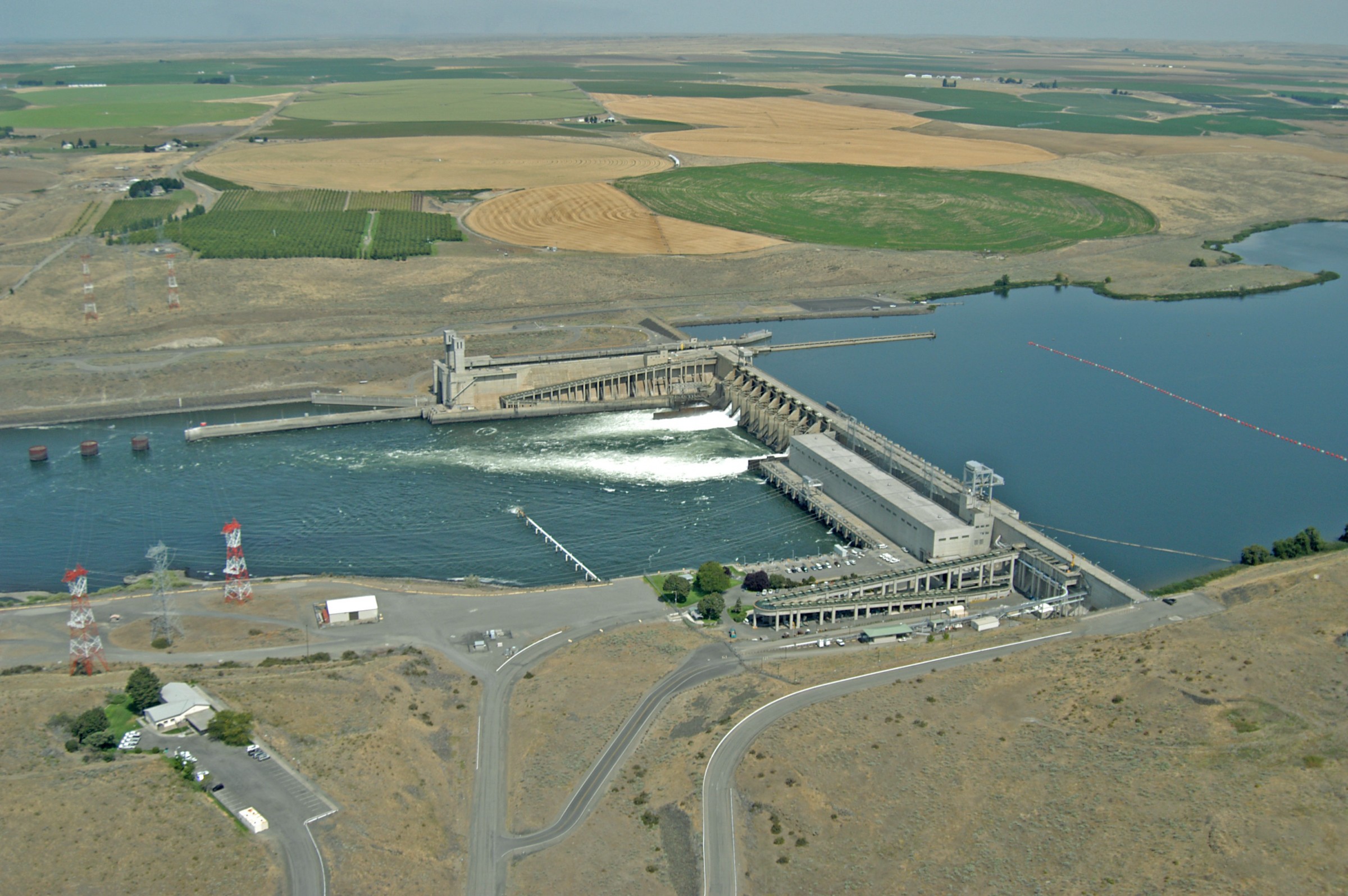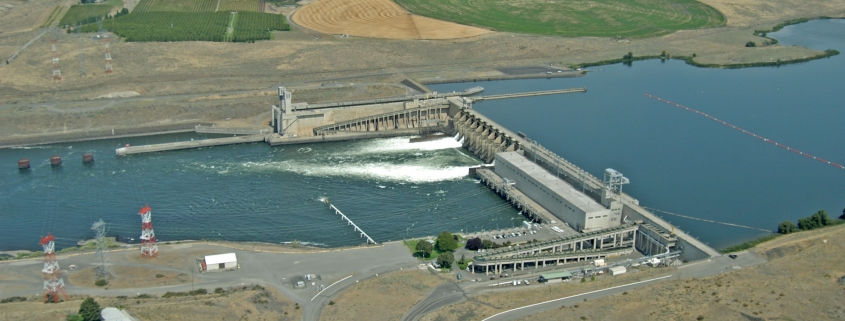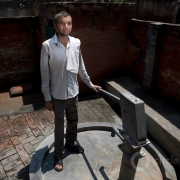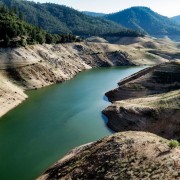Feds Propose River Temperature Limits to Protect Salmon in Pacific Northwest
EPA seeks to keep Columbia and Lower Snake rivers from cooking salmon. It won’t be easy, water experts say.

Ice Harbor Dam, on the Lower Snake River, is owned and operated by the Army Corps of Engineers. It is one of 15 hydropower dams in the Columbia/Lower Snake basin that will be affected by a proposal to limit water temperatures in the river system to protect salmon. Photo courtesy of Flickr/Creative Commons user salmonrecovery
By Brett Walton, Circle of Blue
The U.S. Environmental Protection Agency issued a long-awaited Clean Water Act proposal to limit water temperatures in one of the country’s largest river systems.
The limits, which apply to some 900 miles of the Columbia and Lower Snake rivers, in Oregon and Washington, are intended to protect endangered salmon and other aquatic species from overheating in waters that are exposed to several sources of thermal stress.
Actions to achieve the standards will likely center on operational changes at the 15 hydropower dams in the target area, as well as enhancements to cold-water flows from tributary rivers. These spots provide a cooling refuge for salmon moving upstream.
But bringing down water temperatures across such a large river system will be difficult, water managers in the basin said.
Summer water temperatures, the period of highest stress, have climbed several degrees in many stretches of the Columbia, a river system whose legendary salmon runs have been decimated by dams and now rising temperatures. The dams, which blocked upstream spawning grounds, also absorb heat in their reservoirs.
At the same time, heat-trapping gases in the atmosphere are raising the planet’s temperature. EPA computer models that informed the standards estimate that climate change increased water temperatures in the Columbia and Snake by about 2.7 degrees Fahrenheit since 1970. Water in the rivers is out of compliance even before it reaches the area of concern, with water temperatures exceeding state standards when the rivers cross into Washington from British Columbia and Idaho.
It adds up to a monumental test for regulators and water managers across the two states.
“It’s going to be a challenge for everyone in the basin,” Dianne Barton, water quality coordinator for the Columbia River Inter-Tribal Fish Commission, told Circle of Blue.
Rising Heat
The standards are called a TMDL, which is a tool within the federal Clean Water Act for cleaning up waterways. In effect, a TMDL puts rivers and lakes on a pollution diet in order to meet water quality goals. TMDLs address specific pollutants like phosphorus, sediment, or heat. Often for an individual river, TMDLs occasionally are large and complex, such as the standards for the Chesapeake Bay that apply to six states and the District of Columbia.
The proposed standards for the Columbia and its tributary the Lower Snake vary depending on the stretch of the river and the season. But all the standards seek to keep water temperatures below 68 degrees Fahrenheit, the point at which heat can become fatal to adult salmon.
Implementing the standards is the responsibility of the Washington State Department of Ecology, the Oregon Department of Environmental Quality, and tribal nations. Regulators in those agencies say they are still considering the EPA’s proposal.
“We’re in the process of reviewing it and pulling together our comments,” Melissa Gildersleeve, watershed section manager for Washington State Department of Ecology, told Circle of Blue.
Washington has temperature limits for several smaller rivers, but the scale of this TMDL makes it unique, said Gildersleeve, who added that the big question for regulators is what to do about the federal dams in the target area.
Washington writes Clean Water Act permits for hydropower dams that are owned by public utility districts. Those dams, by and large, already have water temperature management goals written into their permits. But federal dams do not have the same permitting process and do not have specific temperature requirements.
“This will start a conversation with those dams that have not had permits in the past,” Gildersleeve said. “We’ll start talking with them about what things they can do that would help address the temperature problems on the Columbia and Snake system.”
Gildersleeve noted some of the steps that state-regulated dams have taken. The Chelan Public Utility District, for instance, is releasing more water into a section of the Chelan River immediately below the Chelan Dam in order to improve fish habitat.
The Army Corps of Engineers is one federal agency that will be affected by the temperature limits. The Army Corps owns and operates nine dams in the target area.
One of those dams, Dworshak Dam, in Idaho, is a net benefit for temperature management because it is deep enough to hold cold water that can be released throughout the summer to moderate the Lower Snake River.
Matt Rabe, a spokesperson for the Army Corps’ Northwestern Division, told Circle of Blue that the agency is still reviewing the document and will work with Washington and Oregon to develop implementation plans.
The EPA temperature limits come as three other federal agencies — Army Corps, Bonneville Power Authority, and Bureau of Reclamation — are revising management plans for reservoirs in the basin. The goal for both actions is to protect salmon, but the two processes are moving on separate tracks.
A drawback to the temperature limits is that they are generally not directly enforceable against the dams. Requirements can be written into pollution discharge permits, but dam operations have not traditionally been included. The Oregon Department of Environmental Quality objected last month to a draft permit for four federal dams on the Columbia that did not take water temperature into account. Facilities that do need pollution discharge permits — sewage treatment plants, paper processors, chemical manufacturers, ports — have a negligible contribution to the system’s heat imbalance.
Even so, the conversations and management plans that come out of the process are valuable tools for a basin under increasing stress, Gildersleeve argues.
“Whenever we do TMDLs people frequently say, ‘Well, gosh. We can’t get there so we shouldn’t do anything.’’ Gildersleeve said. “And so, one of our key talking points is that it’s really critical to see what can be done and focus on implementation.”
Barton, the water quality coordinator for the tribal fish commission, hopes that the agencies focus on enhancing cold-water refuges, especially at the mouths of tributaries. Some of these spots can become silted and might require dredging, she said.
The EPA published a draft plan last October for protecting these cold-water pools in the Columbia watershed. The agency is waiting on public comments on the TMDL before finalizing that plan. TMDL comments are due by July 21 to ColumbiaRiverTMDL@epa.gov.
All of that is on the table, Gildersleeve said: “Right now, the real focus is identifying those people who are impacting the water for temperature and working together to come up with ideas for what can be done to address temperature on the Columbia and Snake system.”
Brett writes about agriculture, energy, infrastructure, and the politics and economics of water in the United States. He also writes the Federal Water Tap, Circle of Blue’s weekly digest of U.S. government water news. He is the winner of two Society of Environmental Journalists reporting awards, one of the top honors in American environmental journalism: first place for explanatory reporting for a series on septic system pollution in the United States(2016) and third place for beat reporting in a small market (2014). He received the Sierra Club’s Distinguished Service Award in 2018. Brett lives in Seattle, where he hikes the mountains and bakes pies. Contact Brett Walton










Leave a Reply
Want to join the discussion?Feel free to contribute!